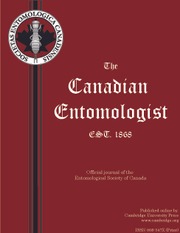Crossref Citations
This article has been cited by the following publications. This list is generated based on data provided by
Crossref.
McAlpine, J. F.
and
Munroe, D. D.
1968.
SWARMING OF LONCHAEID FLIES AND OTHER INSECTS, WITH DESCRIPTIONS OF FOUR NEW SPECIES OF LONCHAEIDAE (DIPTERA).
The Canadian Entomologist,
Vol. 100,
Issue. 11,
p.
1154.
Rajamohan, N.
1976.
Pest Complex of Sunflower — A Bibliography.
PANS,
Vol. 22,
Issue. 4,
p.
546.
Causton, C. E.
and
Rangel, A. Peña
2002.
Field observations on the biology and behaviour of Dasiops caustonae Norrbom and McAlpine (Dipt., Lonchaeidae), as a candidate biocontrol agent of Passiflora mollissima in Hawaii.
Journal of Applied Entomology,
Vol. 126,
Issue. 4,
p.
169.
Araujo, E.L.
and
Zucchi, R.A.
2002.
HOSPEDEIROS E NÍVEIS DE INFESTAÇÃO DE NEOSILBA PENDULA (BEZZI) (DIPTERA: LONCHAEIDAE) NA REGIÃO DE MOSSORÓ/ASSU, RN.
Arquivos do Instituto Biológico,
Vol. 69,
Issue. 2,
p.
90.
Eberhard, William G.
2004.
Male–female conflict and genitalia: failure to confirm predictions in insects and spiders.
Biological Reviews,
Vol. 79,
Issue. 1,
p.
121.
Cumming, Jeffrey M.
Sinclair, Bradley J.
Brooks, Scott E.
O'Hara, James E.
and
Skevington, Jeffrey H.
2011.
The history of dipterology at the Canadian National Collection of Insects, with special reference to theManual of Nearctic Diptera.
The Canadian Entomologist,
Vol. 143,
Issue. 6,
p.
539.
Gisloti, Laura Jane
and
Prado, Angelo Pires do
2013.
Aspectos da biologia e morfologia de machos da mosca-dos-brotos (Diptera: Lonchaeidae).
Arquivos do Instituto Biológico,
Vol. 80,
Issue. 4,
p.
416.
Lemos, Lailson do Nascimento
Adaime, Ricardo
Costa-Neto, Salustiano V.
Deus, Ezequiel da Glória de
Jesus-Barros, Cristiane Ramos de
and
Strikis, Pedro Carlos
2015.
New Findings on Lonchaeidae (Diptera: Tephritoidea) in the Brazilian Amazon.
Florida Entomologist,
Vol. 98,
Issue. 4,
p.
1227.
Vieira, Francieli Nunes da Silva
Sousa, Ester Marques de
Louzeiro, Léo Rodrigo Ferreira
and
Silva, Sara Braga e
2019.
Lonchaeidae (Diptera) species and their host plants in the Cerrado biome in the state of Piauí, Brazil.
Arquivos do Instituto Biológico,
Vol. 86,
Issue. ,
Deady, Rob
and
MacGowan, Iain
2021.
Identification of the Afrotropical lance flySilba laevis(Bezzi, 1920) (Diptera: Lonchaeidae) imported into the United Kingdom.
Journal of Natural History,
Vol. 55,
Issue. 1-2,
p.
67.
MACGOWAN, IAIN
2023.
World Catalogue of the family Lonchaeidae (Diptera, Cyclorrhapha, Acalyptratae).
Zootaxa,
Vol. 5307,
Issue. 1,
p.
1.
Juárez Maya, Miguel
Morales Galván, Óscar
Valdez Carrasco, Jorge
Illescas Salvador, Daniel
Gutierrez Ruelas, José
and
Illescas Riquelme, Carlos
2024.
Morphology of immature stages of the black fig fly Silba adipata (Diptera, Lonchaeidae).
Biodiversity Data Journal,
Vol. 12,
Issue. ,

